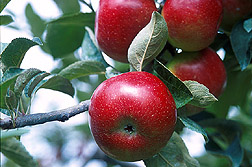This page has been archived and is being provided for reference purposes only. The page is no longer being updated, and therefore, links on the page may be invalid.
|
Read more about kaolin’s agricultural applications in Agricultural Research. |
Mineral Coating Could Cut Chemical Use in AgricultureBy Judy McBrideNovember 1, 2000 KEARNEYSVILLE, W.Va., Nov. 1--Tomorrow’s orchards and vineyards--even row crops--may have a ghostly appearance, based on studies spearheaded by Agricultural Research Service scientists. Researchers at ARS’s Appalachian Fruit Research Station in Kearneysville, W. Va., and collaborators have controlled insects and diseases and prevented sunburn and heat stress by covering fruit trees, vines or vegetable crops with a white, reflective coating of a specially processed kaolin--a type of clay. “Cooperative research and development between ARS and Engelhard Corporation of Iselin, N.J., is producing kaolin-based products that could turn out to be among the most versatile agricultural products ever to hit the market,” said ARS administrator Floyd P. Horn. The agency is the U.S. Department of Agriculture’s chief research arm. And uses for kaolin films don’t end here, according to ARS soil scientist Michael Glenn who conceived of many of their agricultural applications and initiated the cooperation with Engelhard. He and coinventor Gary Puterka see kaolin’s potential as a carrier for just about any chemical used on the farm--pesticide, herbicide or pheromone. “It can serve as a matrix to hold chemicals on the plant or soil and get more even distribution,” said Puterka, an entomologist. “You may be able to reduce the active ingredient by 50 percent or more.” The latest patent application jointly filed by ARS and Engelhard covers this use of kaolin. The first commercial product--Surround Crop Protectant--went on the market in 1999 after pear growers learned that it controlled pear psylla, a devastating insect that is becoming pesticide resistant. This year, Engelhard upgraded it to a wetable powder formulation called Surround WP. Since kaolin is a physical barrier, it must be reapplied to cover new growth or after a heavy rain, which limits its feasibility in rainy areas. However, the severe mid-Atlantic drought of 1999 proved another advantage of the kaolin film in orchards. Treated Empire trees produced apples averaging 17 percent larger than fruit from untreated trees--even trees that were irrigated, said Glenn. And there was no loss in number of fruit. Sekel pears reacted a little differently: Film- covered trees doubled the number of fruit with no loss in fruit size. Glenn explained that the specially processed kaolin coat reflects the heating infrared wavelengths, as well as the burning ultraviolet rays. It’s the ability to keep the tree cooler under a blazing sun that increases yield. On the West Coast, kaolin film prevented sunburn on apples and walnuts, Glenn added. Sunburn damage makes a perfect niche for rot organisms. So packers pay bottom dollar for produce with blemished skin or shells, or reject it altogether. In studies here and in South America, South Africa, and Australia/New Zealand--”the kaolin- based product has cut sunburn damage on apples in half, on average,” Glenn said. Around the country, kaolin film has controlled well over a dozen species of insects and mites. Studies to evaluate it against the glassywing sharpshooter in California vineyards are in progress, and results so far look encouraging. According to Puterka, the specially formulated kaolin particles “have the potential to work against almost any insect. The key is getting good coverage of the crop.” And with some changes in formulation, Glenn and Kearneysville colleague Michael Wisniewski are demonstrating that the films have potential to control diseases in orchards or keep vegetable crops viable several degrees below their normal threshold for frost damage. Read more about kaolin’s agricultural applications in the November issue of Agricultural Research magazine. Scientific contact: Michael Glenn and Gary Puterka, ARS Appalachian Fruit Research Station, Kearneysville, W.Va., phone (304) 725-3451, ext. 321 [Glenn], ext. 361 [Puterka], fax (304) 728-2340, mglenn@afrs.ars.usda.gov, gputerka@afrs.ars.usda.gov. |


